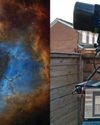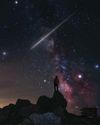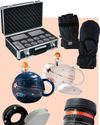
Six decades ago, human spaceflight was a two-sided coin, as the United States and Soviet Russia competed for primacy in the Space Race during the Cold War. With global nuclear holocaust looming menacingly on the horizon, parallel space programmes arose on opposite sides of the Iron Curtain: Mercury versus Vostok, Gemini versus Voskhod, Soyuz versus Apollo and the Space Shuttle.
Today, this East/West duopoly has ceded a few grains of its dominance to newer players. National actors like China and India have emerged like a whirlwind, along with a growing chorus of commercial entities from Boeing to SpaceX, and Blue Origin to Virgin Galactic, all hungrily eyeing the space domain.
When Yuri Gagarin conquered space in April 1961, the door creaked ajar for others to follow. But initially, those 'others' were exclusively military; for the average person in the street, the chance to fly into space was a door that was firmly barred and bolted.
Today, fewer than 700 souls - less than 0.00001 per cent of the world's 8.1 billion population - have experienced microgravity and seen Earth as it truly is: a fragile, glowing oasis of colour set jewel-like against the ethereal darkness of the cosmos.
And when that miniscule number filters down to 'ordinary' people like you and me, the odds of reaching space are vanishingly remote. We humans are a long way from becoming a spacefaring species.
Yet with new spacecraft taking shape, this status quo is on the cusp of monumental change.
Despite their decades-held duopoly, Russia and the United States have courted participation from other nations and walks of life in a highly visible example of politicised soft power. Between the 1960s and the close of the 20th century, the number of first-time space travellers quadrupled, from 45 individuals (including one woman) from two nations to 170 individuals (including 28 women) from 14 nations.
Diese Geschichte stammt aus der August 2024-Ausgabe von BBC Sky at Night Magazine.
Starten Sie Ihre 7-tägige kostenlose Testversion von Magzter GOLD, um auf Tausende kuratierte Premium-Storys sowie über 8.000 Zeitschriften und Zeitungen zuzugreifen.
Bereits Abonnent ? Anmelden
Diese Geschichte stammt aus der August 2024-Ausgabe von BBC Sky at Night Magazine.
Starten Sie Ihre 7-tägige kostenlose Testversion von Magzter GOLD, um auf Tausende kuratierte Premium-Storys sowie über 8.000 Zeitschriften und Zeitungen zuzugreifen.
Bereits Abonnent? Anmelden

Putting cosmic rays to work
These penetrating interstellar particles have applications from astronomy to archaeology

Set up your first imaging sequence
How to automate and coordinate your gear over multiple nights of imaging

The Universe without gravity
Life with no gravity might sound a fun idea, but as Govert Schilling explains, shutting off this pivotalforce would spell disaster for Earth and beyond

How to blend images taken with different camera setups
Combine data captured at varied focal lengths to create rich, deep images

INSIDE THE SKY AT NIGHT
Back in September 2021, The Sky at Night show spoke to Carly Howett about NASA's then upcoming Lucy mission. As the spacecraft now approaches its main targets - the Trojan asteroids - we check in with her to see how the mission is going

The science of SCI-FI
We love a good sci-fi film, but do they get the science right? Amy Arthur picks six of the big mistakes made in space films

Seeing in a new light
It's National Astronomy Week this month, so take a tip from Mark Westmoquette and let mindful stargazing change your perspective on your life and problems

What to do if you find a meteorite
Ever come across an unusual rock and wondered if it's a meteorite? Mark McIntyre explains how to tell if that stone really is a fragment from outer space

GEAR
Charlotte Daniels rounds up the latest astronomical accessories

Q&A WITH A STELLAR ECLIPSE SPECIALIST
Many stars are gravitationally locked inside multi-star systems, but a rare new triple-star system has set a new record for how cosy these clusters can get